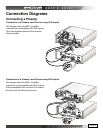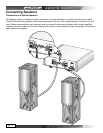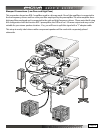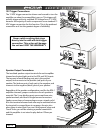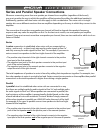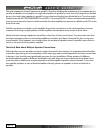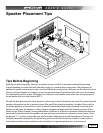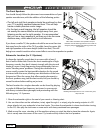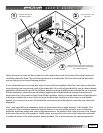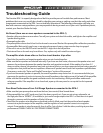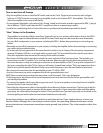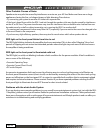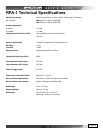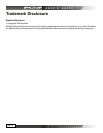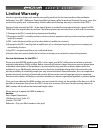
Page 22
Page 23
Troubleshooting Guide
The Emotiva RPA-1 is expertly designed and built to provide years of trouble-free performance. Most
problems that occur can usually be solved by checking your setup or making sure that the audio and video
components connected to the RPA-1 are on and fully operational. The following information will help you
deal with common setup problems you may experience during normal use of your unit. If problems persist,
contact your Emotiva Dealer for help.
No Sound (from one or more speakers connected to the RPA-1)
• Speaker cables may have come undone. Turn o your system and check the cables, and tighten the amplier and
speaker binding posts.
• Damaged audio cable.
• The preamplier volume level is low for the channels concerned. Recheck the preamplier calibration procedure.
• A preamplier Mute switch may be on, or an external processor loop or a tape monitor loop is engaged.
• If the unit is not on, the ON/OFF switch on the RPA-1 might be in the o position.
• The internal fuse on the unit may have blown. If so, replace only with rated fuse size and type.
The amplier shuts down often or the line circuit breaker trips often
• Check that the positive and negative speaker wires are not shorted together.
• Make sure that no speakers are shorted internally. If you have an ohm-meter, disconnect the speaker wires and
measure the resistance between the speaker’s positive and negative terminals. If the reading is less than 3.2
ohms on either channel, the speakers may have an internal short or you have connected several using a parallel
conguration that yields too low an impedance. Measure all speakers and check their impedance specications.
If necessary, review the “Series and Parallel Connections” section of this manual.
• If you have connected speakers in parallel, the overall impedance may be too low. It is recommended that you
rearrange the speakers in series to increase the overall impedance, thus taking some of the load o the amplier.
• Make sure that the amplier has good ventilation and is not overheating. Allow good airow underneath
wherever possible. If the amplier is in a closed rack, open up the rear panel or use a quiet fan for improved
ventilation.
Poor Bass Performance From Full Range Speakers connected to the RPA-1
• Make sure that your preamp does not have the bass (tone control) level turned down.
• If the preamplier has a HPF, make sure that it has been correctly set. If you are not using a subwoofer, set
the high pass lter to “BYPASS” (if available) or just use full range outputs into RPA-1 so that there is no path
through a crossover and the speakers will play full range.
• Check that the speaker wires have been connected correctly: Make sure that the positive of each speaker
connects to a positive output of the amplier, and the negative of each speaker connects to a negative
output. If one speaker is wired incorrectly, than it will be “out of phase” with the others, resulting in poor bass
performance. DOUBLE CHECK ALL THE SPEAKER CONNECTIONS!!



